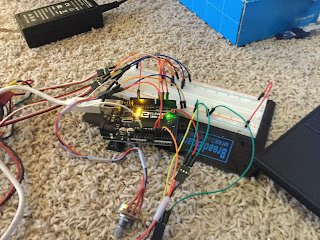After some time, I presented my work to a friend in the product design field. He liked where this was going, but he did not like the boxy, chunky demeanor of the current design. To show me what He thought it should look like, he quickly drew up the following idea sketch.
This sketch later became the cornerstone whenever aesthetics where involved. After several design iterations and updates, I had myself a product that looked quite similar to the above sketches (except that this one could actually work). I deemed it "The Mayor"
I soon realized that the blaster's signature front foregrip was, sadly, too small to fit in the ESC's. It could work if the Esc's used were smaller, but the ones I was currently using were big and chunky by comparison, so a different foregrip was needed to fit them. The result is pictured below. It is not quite as good looking as that original design, but it works and still looks decent at the same time.
The weapon looks pretty neat in a digital rendering, but how about real life? Would it function as desired? That is what I next planned to find out.
A little pretext here, (an excuse, if you will) I printed the entirety of the Mayor in ABS plastic, which, warps. Big time. Until the last few prints, I had used ABS slurry and masking tape to hold the plastics down. This lessened the warping, but did not rid me of it entirely. Many of the pieces you see here will be reprinted later, as I now have a nice PEI bed the holds prints like these firmly in place.
On the plus side, things fit well in the blaster and worked accordingly. The next step was to put it together. The Mayor had several shortcomings when it comes to assembly. There are several locations (like where the screws hold on the trigger and the shroud) where the screws bore into, and get their hold from, plastic. This is not good at all. I spent quite some time thinking on how to combat this, and have only recently come up with the solution, so the weapon in the images below does not have these improvements (yet).




For the flywheel cage, I used and ideation similar to that of torukmakto4 and FDL-1 (as stated in a previous blog) when producing it. There is, however a major difference between those cages and the one I am currently using. They both have their motors screwed directly into the plastic. Unlike the mentioned people, I implemented some nice, metal motor brackets for the motors to be screwed into. Those, in turn, are then screwed into the cage with 4 larger, stronger screws. This creates a wider anchor range and is less likely to shear off due to normal wear and tear.



The Mayor uses 2205 type brushless motors with 2300 KV rating. The flywheels, as mentioned in the original post are 9.5mm (crush space). This setup on 3s yields roughly 150 FPS, the same as a typical FDL blaster. (you see me making many references to FDL, and that is because it is the brushless standard in the nerfing community). The T19 yields 180 FPS, and that is because it runs on a 4s setup. If the Mayor were to also use a 4s LiPo, output would be roughly the same, as most other aspects (I.E motor type, etc.) are pretty similar across both platforms. The battery tray is plenty big enough for a 4s LiPo, so switching to a beefier battery is as simple as plugging one in.
Unfortunately, while testing, I had a mishap with a simonK firmware and it took out 2 of my ESCs and one motor with a fantastic
bang. I, luckily have spare Esc's, but will need fresh motors to fully complete the weapon.
Current iteration files are on
Thingiverse and source code will be up on GitHub soon.














































